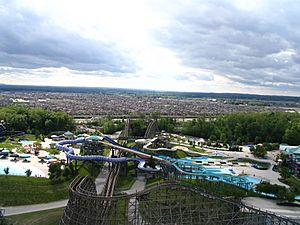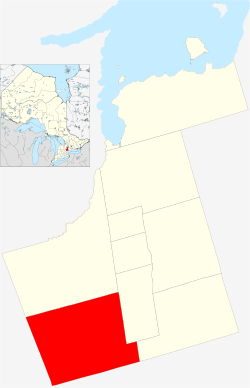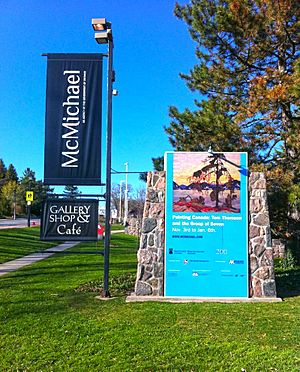Vaughan facts for kids
Quick facts for kids
Vaughan
|
|||||
|---|---|---|---|---|---|
| City of Vaughan | |||||

Vaughan viewed from Canada's Wonderland
|
|||||
|
|||||

Location of Vaughan within York Region
|
|||||
| Country | Canada | ||||
| Province | Ontario | ||||
| Regional Municipality | York | ||||
| Communities |
List of major subdivisions
|
||||
| Settled | 1792 | ||||
| Incorporated | |||||
| • Township | 1850 | ||||
| • City | 1991 | ||||
| Government | |||||
| • Type | Municipal (City) | ||||
| Area | |||||
| • Land | 272.44 km2 (105.19 sq mi) | ||||
| Population
(2021)
|
|||||
| • Total | 323,103 (17th) | ||||
| • Density | 1,185.9/km2 (3,071/sq mi) | ||||
| • Total Private Dwellings | 107,159 | ||||
| Time zone | UTC-5 (EST) | ||||
| • Summer (DST) | UTC-4 (EDT) | ||||
| Area code(s) | 905, 289, 365, and 742 | ||||
| Website | www.vaughan.ca | ||||
Vaughan (2021 population 323,103) is a city in Ontario, Canada. It is located in the Regional Municipality of York, just north of Toronto. Vaughan was the fastest-growing municipality in Canada between 1996 and 2006 with its population increasing by 80.2% during this time period and having nearly doubled in population since 1991. It is the fifth-largest city in the Greater Toronto Area, and the 17th-largest city in Canada.
Contents
History
In the late pre-contact period, the Huron-Wendat people populated what is today Vaughan. The Skandatut ancestral Huron village overlooked the east branch of the Humber River (Pinevalley Drive) and was once home to approximately 2000 Huron in the sixteenth century. The site is close to a Huron ossuary (mass grave) uncovered in Kleinburg in 1970, and one kilometre north of the Seed-Barker Huron site
The first European to pass through Vaughan was the French explorer Étienne Brûlé, who traversed the Humber Trail in 1615. However, it was not until the townships were created in 1792 that Vaughan began to see settlements, as it was considered to be extremely remote and the lack of roads through the region made travel difficult. The township was named after Benjamin Vaughan, a British commissioner who signed a peace treaty with the United States in 1783.
Despite the hardships of pioneer life, settlers came to Vaughan in considerable numbers. The population grew from 19 men, 5 women, and 30 children in 1800 to 4,300 in 1840. The first people to arrive were mainly Pennsylvania Germans, with a smaller number of families of English descent and a group of French Royalists. This migration from the United States was by 1814 superseded by immigrants from Britain. While many of their predecessors had been agriculturalists, the newer immigrants proved to be highly skilled tradespeople, which would prove useful for a growing community.
Around the facilities established by this group were a number of hamlets, the oldest of which was Thornhill, which witnessed the construction of a saw-mill in 1801, a grist mill in 1815, and boasted a population of 300 by 1836. Other such enclaves included Kleinburg, Coleraine, Maple, Richmond Hill, Teston, Claireville, Pine Grove, Carrville, Patterson, Burlington, Concord, Edgeley, Fisherville, Elder's Mills, Elgin Mills, Jefferson, Nashville, Purpleville, Richvale, Sherwood, Langstaff, Vellore, and Burwick (Woodbridge).
Vaughan changed little in its early history, from the 1840s when the number of inhabitants stood at 4,300 to 1935 when it had 4,873 residents. However, World War II sparked an influx of immigration, and by 1960, the population stood at 15,957. As well, the ethno-cultural composition of the area began to change with the arrival of different groups such as Italians, Jews and Eastern Europeans.
Incorporated in 1850 as Vaughan Township, a municipal government was established. Vaughan Road was a rural road constructed in 1850 that linked Vaughan Township with Toronto, though this street's current alignment is much shorter and serves only much of the eastern half of the former city of York. In 1971, the new regional government of York Region was established, acquiring policing and welfare services from the communities it served; simultaneously, the township merged with the Village of Woodbridge to form the Town of Vaughan. In 1991, it officially changed its legal status to City of Vaughan.
An F2 tornado tore through the city of Vaughan during the Southern Ontario Tornado Outbreak on August 20, 2009. Premier Dalton McGuinty and Mayor Linda Jackson toured the destruction the next day and reported 200 homes in critical shape and as many as 600 additional homes likely to be demolished. The tornado also ripped up trees, flipped cars, and left thousands of people without power. Vaughan declared a state of emergency because of the widespread damage. One man injured in the storm suffered a heart attack the following morning.
Geography
Vaughan is bounded by Caledon and Brampton to the west, King and Richmond Hill to the north, Markham and Richmond Hill to the east, and Toronto, to the south. It is located approximately 25 minutes from Downtown Toronto.
Climate
Vaughan like much of the Greater Toronto Area features a continental climate Dfb and has four distinct seasons.
| Climate data for Vaughan 1981–2010 (Woodbridge) | |||||||||||||
|---|---|---|---|---|---|---|---|---|---|---|---|---|---|
| Month | Jan | Feb | Mar | Apr | May | Jun | Jul | Aug | Sep | Oct | Nov | Dec | Year |
| Record high °C (°F) | 17.0 (62.6) |
15.5 (59.9) |
26.5 (79.7) |
31.5 (88.7) |
33.0 (91.4) |
36.0 (96.8) |
39.0 (102.2) |
37.2 (99.0) |
36.1 (97.0) |
30.6 (87.1) |
25.0 (77.0) |
19.5 (67.1) |
39.0 (102.2) |
| Average high °C (°F) | −2.5 (27.5) |
−0.5 (31.1) |
4.3 (39.7) |
12.0 (53.6) |
18.8 (65.8) |
24.1 (75.4) |
26.9 (80.4) |
25.4 (77.7) |
20.9 (69.6) |
13.9 (57.0) |
6.9 (44.4) |
0.8 (33.4) |
12.6 (54.7) |
| Daily mean °C (°F) | −6.6 (20.1) |
−4.8 (23.4) |
−0.4 (31.3) |
6.6 (43.9) |
12.9 (55.2) |
18.1 (64.6) |
20.8 (69.4) |
19.6 (67.3) |
15.4 (59.7) |
9.0 (48.2) |
3.1 (37.6) |
−2.8 (27.0) |
7.6 (45.7) |
| Average low °C (°F) | −10.7 (12.7) |
−9.2 (15.4) |
−5.2 (22.6) |
1.2 (34.2) |
6.8 (44.2) |
12.0 (53.6) |
14.7 (58.5) |
13.8 (56.8) |
9.8 (49.6) |
4.0 (39.2) |
−0.8 (30.6) |
−6.4 (20.5) |
2.5 (36.5) |
| Record low °C (°F) | −34.5 (−30.1) |
−30.0 (−22.0) |
−29.4 (−20.9) |
−17.2 (1.0) |
−6.7 (19.9) |
−1.7 (28.9) |
2.8 (37.0) |
−0.6 (30.9) |
−5.0 (23.0) |
−11.7 (10.9) |
−18.3 (−0.9) |
−30.0 (−22.0) |
−34.5 (−30.1) |
| Average precipitation mm (inches) | 50.3 (1.98) |
44.2 (1.74) |
49.2 (1.94) |
63.3 (2.49) |
79.1 (3.11) |
76.3 (3.00) |
70.4 (2.77) |
80.4 (3.17) |
84.6 (3.33) |
66.5 (2.62) |
78.3 (3.08) |
57.4 (2.26) |
799.8 (31.49) |
| Average rainfall mm (inches) | 20.4 (0.80) |
23.2 (0.91) |
31.4 (1.24) |
59.6 (2.35) |
79.1 (3.11) |
76.3 (3.00) |
70.4 (2.77) |
80.4 (3.17) |
84.6 (3.33) |
66.0 (2.60) |
71.1 (2.80) |
34.6 (1.36) |
697.0 (27.44) |
| Average snowfall cm (inches) | 29.9 (11.8) |
21.1 (8.3) |
17.8 (7.0) |
3.7 (1.5) |
0.0 (0.0) |
0.0 (0.0) |
0.0 (0.0) |
0.0 (0.0) |
0.0 (0.0) |
0.45 (0.18) |
7.2 (2.8) |
22.8 (9.0) |
102.8 (40.5) |
| Average precipitation days (≥ 0.2 mm) | 13.5 | 10.3 | 10.7 | 11.8 | 12.0 | 10.8 | 9.5 | 9.6 | 10.6 | 12.7 | 13.1 | 12.8 | 137.4 |
| Average rainy days (≥ 0.2 mm) | 4.2 | 4.4 | 6.4 | 10.7 | 12.0 | 10.8 | 9.5 | 9.6 | 10.6 | 12.6 | 11.1 | 6.5 | 108.3 |
| Average snowy days (≥ 0.2 cm) | 10.2 | 6.8 | 5.1 | 1.5 | 0.0 | 0.0 | 0.0 | 0.0 | 0.0 | 0.23 | 3.0 | 7.5 | 34.3 |
| Source: Environment Canada | |||||||||||||
Communities
The city is made up of six major communities. They are commonly seen today to extend to areas far beyond their original sites that encompass lesser-known communities in turn. Most residents (and even non-residents) identify more with them then they do with the city as a whole.
- Woodbridge: North/South - Major Mackenzie/Steeles, East/West - Hwy 400/Hwy 50
- Vaughan Metropolitan Centre: North/South - Hwy 7/Steeles, East/West - Jane/Hwy 400
- Maple: North/South - King Vaughan Line/Rutherford, East/West - Bathurst/Hwy 400
- Thornhill: North/South - Hwys. 7 and 407 (or, to some, as far north as Teston for the area west of Bathurst) /Steeles, East/West - Yonge/Dufferin
- Concord: North/South - Rutherford/Steeles, East/West - Bathurst/Hwy 400
- Kleinburg: North/South - King Vaughan Line/Major Mac, East/West - Hwy 400/Hwy 50
Even though Vaughan is a city, it is not listed in the phone book. Instead, Bell Canada uses the original community exchanges and lists them separately, resulting in local calling areas being different throughout the city.
Transportation
Demographics
| Ethnic Origin (2016) | Population | Percent |
|---|---|---|
| Italian | 94,730 | 31.1 |
| Russian | 25,635 | 8.4 |
| Canadian | 24,185 | 8.0 |
| Chinese | 24,130 | 7.9 |
| East Indian | 20,595 | 6.7 |
| Polish | 18,265 | 6.0 |
| Jewish | 13,650 | 4.5 |
| English | 11,575 | 3.8 |
| Ukrainian | 9,570 | 3.1 |
| Portuguese | 9,145 | 3.0 |
| Filipino | 9,140 | 3.0 |
| Irish | 7,185 | 2.4 |
| Vietnamese | 6,845 | 2.2 |
| Scottish | 6,775 | 2.2 |
| Iranian | 6,685 | 2.2 |
| Historical populations | ||
|---|---|---|
| Year | Pop. | ±% |
| 1971 | 16,189 | — |
| 1976 | 18,120 | +11.9% |
| 1981 | 30,386 | +67.7% |
| 1986 | 67,595 | +122.5% |
| 1991 | 115,477 | +70.8% |
| 1996 | 132,549 | +14.8% |
| 2001 | 182,022 | +37.3% |
| 2006 | 238,866 | +31.2% |
| 2011 | 288,301 | +20.7% |
| 2016 | 306,233 | +6.2% |
| 2021 | 323,103 | +5.5% |
In the 2021 Census of Population conducted by Statistics Canada, Vaughan had a population of 323,103 living in 103,914 of its 107,159 total private dwellings, a change of 5.5% from its 2016 population of 306,233. With a land area of 272.44 km2 (105.19 sq mi), it had a population density of 1,186.0/km2 (3,072/sq mi) in 2021.
Median age as of 2016 was 40.2, lower than the Ontario median age of 41.3. Visible minorities make up 35.4% of the population.
According to the 2016 Census, English is the mother tongue of 45.2% of the residents of Vaughan. Italian is the mother tongue for 12.3% of the population, followed by Russian (6.8%) and Mandarin (2.9%). Each of Spanish, Persian, Cantonese, Urdu, Punjabi, Hebrew, Tagalog (Filipino), Vietnamese, Portuguese, and Korean have a percentage ranging from 2.4% to 1.4%, signifying Vaughan's high linguistic diversity.
As of 2011, 60.6% of the city's population identifies as Christian, mostly Catholic (46.2%), followed by Orthodox (4.9%). Others identify as Jewish (15.3%), Muslim (4.9%), Hindu (4.5%), Buddhist (2.5%), and Sikh (1.8%). Those who do not have a religious affiliation account for 10% of the population.
Attractions
- Baitul Islam Mosque, headquarters of the Canadian Ahmadiyya Muslim community
- Boyd Conservation Area, park located Between Woodbridge and Kleinburg southeast of the intersection of Islington Avenue and Rutherford Road.
- Canadian Soccer Hall of Fame and Museum
- Canada's Wonderland, Canada's largest amusement park, located in Maple on the east side of Highway 400 between Rutherford Road and Major Mackenzie Drive.
- Kortright Centre for Conservation, located in Woodbridge
- McMichael Canadian Art Collection, located in Kleinburg.
- Vaughan Mills, a large shopping mall opened in 2004
- Reptilia Zoo, a 25,000 sq ft Reptile Zoo and Education Centre located near Vaughan Mills and Canada's Wonderland
- J. E. H. MacDonald House
Archaeology
The Seed-Barker archaeological site is a 16th-century Iroquois village on the Humber River in Vaughan. It has been used as a summer school field trip site since 1976 by the Boyd archaeological field summer school for high school students. The school is sponsored by the York Region district school board in co-operation with the Royal Ontario Museum and the Toronto and Region Conservation Authority (TRCA). In 1895, a local farmer began finding Iroquoian artifacts in the area. In 1895, Roland Orr recognized the classic ecological features favoured by the Iroquoian people for their villages: floodplains along a river, an easily defensible plateau and nearby forests. The Iroquois used the floodplains to plant maize, beans and squash, known as the three sisters. In the 1950s, University of Toronto professor Norman Emerson and the students excavated artifacts from the Seed-Baker site. Since 1975, more that a million artifacts were discovered and nineteen longhouses were excavated revealing that the village was occupied by the Iroquois from c. 1500 - 1550 AD.
Twin cities
 Sora, Italy (1992)
Sora, Italy (1992) Ramla, Israel (1993)
Ramla, Israel (1993) Sanjō, Japan (1993)
Sanjō, Japan (1993) Yangzhou, China (1995)
Yangzhou, China (1995) Baguio, Philippines (1997)
Baguio, Philippines (1997) Delia, Italy (1998)
Delia, Italy (1998) Lanciano, Italy (2002)
Lanciano, Italy (2002)
In film
Kleinburg is home to the Cinespace Film Studios, a centre for television and motion picture production. Several famous movie stars are often spotted around Kleinburg, making it a popular tourist/gawker attraction. The popular children's TV show The Forest Rangers, starring Gordon Pinsent, was filmed here between 1963 and 1965. In 2006, the movie The Sentinel was filmed at the McMichael Art Gallery.
Economy
Within the Greater Toronto Area, Vaughan is the third-largest employment center, after Toronto and Mississauga. With a real Gross Domestic Product (GDP) of $20.6 billion in 2018, it is the largest contributor (35%) to York Region's economy.
In 2018, the city was home to 12,105 businesses employing more than 222,000 people. Between 2008 and 2018, Vaughan's average annual employment growth was 3.2% and its business growth was 2.9%, exceeding provincial and national rates.
Manufacturing continues to dominate the local economy, accounting for 22% of total employment, followed by Construction (13%), Retail Trade (12%), Wholesale Trade (10%) and Transportation and Warehousing (6%). Small businesses with fewer than 20 employees account for 81% of all business establishments.
In 2018, the Accommodation and Food Services industry accounted for $295 million of Vaughan's real gross domestic product. Vaughan currently has 12 hotels and four motels with a total of 1,845 rooms. Development applications have been submitted that have the potential to add another 1,200 rooms to current supply in the coming years. Major tourism operators include Canada's Wonderland, Vaughan Mills, the McMichael Canadian Art Collection, the Kortright Centre for Conservation, LEGOLAND Discovery Centre, Reptilia, the mainstreet and village cores of Kleinburg, Thornhill, and Woodbridge.
Construction activity, as measured by value of building permits, has exceeded the $1 billion mark in eight of the last ten years.
As of 2018, the largest employers in Vaughan are:
- Canada's Wonderland
- United Parcel Service (UPS) Canada
- Canadian National Railway
- KPMG
- Bondfield Construction
- Ganz
- NPL Canada Ltd.
- Condrain Company Ltd.
- Ozz Electric
- Rollstamp Manufacturing
Vaughan is home to 184 Canadian or regional headquarters, including:
- Adidas Canada
- GFL Environmental
- Recipe Unlimited
- St. Joseph Communications
- Toys "R" Us
- Yum! Brands
Education
York University in North York, Ontario lies on the Toronto side of the Toronto-Vaughan border. It is a major comprehensive university, with more than 43,000 students enrolled through 10 different faculties.
There are also a number of elementary and high schools in Vaughan, which operate under the York Region District School Board, the York Catholic District School Board, Conseil scolaire catholique MonAvenir (French-language Catholic schools) and Conseil scolaire Viamonde (French-language public schools). There is also a Waldorf school, the Toronto Waldorf School, which offers early childhood, elementary and accredited high school programs.
The American private Catholic Niagara University runs a branch campus in Vaughan, its first university in the city. The Ontario branch of Niagara University opened a 12,000 square foot facility at Expo City in downtown Vaughan. This campus will offer Master of Science in Education and Bachelor of Professional Studies in Education programs.
Notable people
Order of Vaughan
In 2016, to celebrate the city's 25th anniversary, Mayor Bevilacqua introduced the Order of Vaughan. This award is meant to be the highest honour bestowed by the city. Initially, 25 recipients were given the award as a reflection of the anniversary; however, the city announced in 2017 that up to ten new individuals would receive the award each year thereafter. The award is meant to recognize people in the categories of: accessibility, arts and entertainment, athletics, business, education, environment and spirituality, equity and diversity, health and wellness, media and communications, not-for-profit, philanthropy, public service, and science and technology.
Images for kids
See also
 In Spanish: Vaughan (Ontario) para niños
In Spanish: Vaughan (Ontario) para niños







